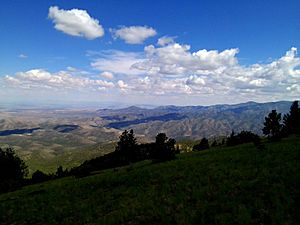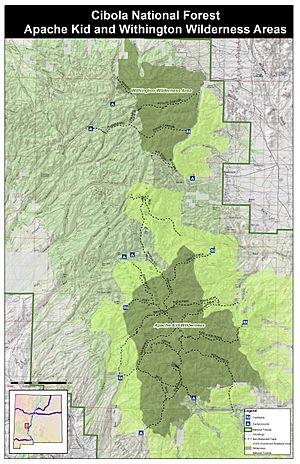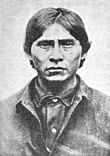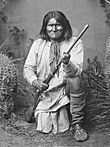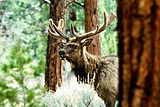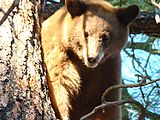San Mateo Mountains (Socorro County, New Mexico) facts for kids
The San Mateo Mountains are a mountain range located in Socorro County, in the western part of New Mexico. These mountains are a special place in the southwestern United States. The highest point in the range is West Blue Mountain, which stands tall at 10,336 feet (3,151 meters).
The range stretches about 40 miles (64 km) from north to south. It's located about 25 miles (40 km) north of the town of Truth or Consequences. It's also about 30 miles (48 km) southwest of Socorro. It's important not to confuse these mountains with another range that has the same name. That other range is found in Cibola and McKinley counties, further north.
Most of the San Mateo Mountains are part of the Magdalena Ranger District. This district belongs to the Cibola National Forest. There are two special protected areas here called wilderness areas. These are the Apache Kid Wilderness, which covers about 44,650 acres (181 km²), and the Withington Wilderness, which is about 18,869 acres (76 km²). These areas help protect the natural environment.
Contents
How the Mountains Were Formed: Geology
The San Mateo Mountains were created by a process called fault-block formation. This means large blocks of the Earth's crust moved along cracks, or faults, pushing some parts up and others down. These mountains are made of volcanic rock. This rock formed between 24 and 28 million years ago from the Datil-Mogollon Volcanic Field.
The San Mateo Mountains are also part of the western edge of the Rio Grande Rift Valley. This is a huge crack in the Earth's crust where the land is slowly pulling apart. The mountains also form the eastern border of the Plains of San Agustin. This flat area is famous for the Very Large Array, a huge group of radio telescopes used to study space.
Some of the important peaks in the San Mateo Mountains include:
| Mountain | Height (ft) | Height (m) |
|---|---|---|
| West Blue Mountain | 10,783 | 3,287 |
| Vic's Peak | 10,252 | 3,125 |
| San Mateo Mountain | 10,145 | 3,092 |
| San Mateo Peak | 10,139 | 3,090 |
| Mount Withington | 10,115 | 3,083 |
| Apache Kid Peak | 10,048 | 3,063 |
History and People of the San Mateos
The San Mateo Mountains have a long and interesting history. People have lived in this area for about 14,000 years! Early people, known as Paleoindians, lived here. They hunted large animals that are now extinct.
For many years, the Apache people considered much of this area their home. They lived in the Magdalena-Datil region from the 1600s until the late 1800s. Famous Apache leaders like Cochise and Geronimo had connections to these mountains. Vic's Peak is named after Victorio, a brave Apache leader. He was known for standing up for his people. The Apache Kid, another famous figure, is even said to be buried in the Apache Kid Wilderness. Stories about him are a big part of the local history.
Even in the early 1900s, Native Americans were still using these mountains. A famous conservationist named Aldo Leopold wrote about finding an abandoned Native American hunting camp here in 1919.
- Cultural or Historic Figures with Ties to the San Mateo Mountains
-
Aldo Leopold.jpg
Aldo Leopold was an ecologist, author, and forester influential in the development modern conservation ethics.
After the Apache conflicts, people came looking for gold, silver, and copper. While some mining happened in the late 1800s, you can barely see any signs of it today. The old mines have collapsed, and plants have grown over them.
During the late 1800s and early 1900s, ranchers also used the mountains. They drove thousands of sheep and cattle to stockyards in Magdalena. This village was connected by train to Socorro. The last regularly used cattle trail in the United States was here. It was called the Magdalena Livestock Driveway, or the "Beefsteak Trail." This trail was used from 1865 until 1971, when trucks started to be used instead.
Amazing Wildlife in the Mountains
The San Mateo Mountains are home to many different animals. You might spot mountain lions, black bears, and elk. There are also mule deer, pronghorn, and wild turkeys. Birds like the goshawk live here too.
The mountains are very important for the threatened Mexican spotted owl. They have special areas that are critical for these owls to live and raise their young. The forests here are full of different trees. You can find ponderosa pines, oak trees, aspens, spruce, fir, and three types of juniper trees.
In 2004, a group called The Nature Conservancy said the San Mateos were a key area for conservation. This is because they have so many different types of plants and animals. They are also an important place for mountain lions to breed.
- Wildlife in the San Mateo Mountains
Fun Things to Do: Recreation
The San Mateo Mountains offer many fun activities for visitors. You can go hiking on trails, camp under the stars, or go backpacking deep into the wilderness. It's also a great place for hunting, horseback riding, and stargazing.
There are four developed campsites in or near the San Mateos. These include Springtime, Luna Park, Bear Trap, and Hughes Mills campgrounds. One of these, Hughes Mills, gives you access to a hiking trail that leads to the Mt. Withington lookout.


